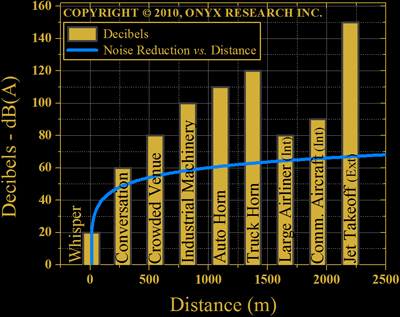_October2013_small-c5284e74ed9ef79f612813617b47061d92bf282e0f0f8ff07179efcb1aa8cc1a.jpg)
|
Research & Analysis for Business and Investment Clients |
|
Serenity Now: Noise Affects Your Sleep, Work, & Concentration.
Here's what you can do.
Truck traffic, construction, airplanes, sirens, and obnoxious cell phones have you down? Feeling tired and agitated when you wake? Not surprising.
Street noise, subways, trains, and airplanes generate significant noise (80-90 decibels - dB(A)). Exposure can raise blood pressure, make you tired in the morning, and, in rats, even affect heart cell structure at ~100 dB(A).
In 1900, Americans lived in rural locations (only 40% lived in urban environments). In 2000, little urban achievers reached more than 80%. With traffic, construction, jets, sirens, and cell phones, American lives are noisier.
Whether you are a parent, city-dweller, flight attendant, or commuter, reducing noise in your life will reduce your stress.
Figure 1 plots noise intensities for different noise generators. The blue line indicates how noise intensity drops vs. distance (free space propagation). For most noise intensities, moving 100 meters away significantly reduces noise. If you are considering moving near an airport, you'll want to leave considerable distance.
 Figure 1. Noise levels for whispers, speech, conversations, horns, and jets. The blue line plots noise intensity reduction as a function of distance. A large improvement is obtained initially with a small separation from the source.
Figure 1. Noise levels for whispers, speech, conversations, horns, and jets. The blue line plots noise intensity reduction as a function of distance. A large improvement is obtained initially with a small separation from the source.

Physiological Responses to Noise
Sounds are processed by the primary auditory cortex and connected neurons in the brain. When noise is significant or startling, the nervous system reacts by increasing blood pressure (think fight or flight). Given noise is a stressor, stress compensating molecules like cortisol, adreno- corticotropic hormone (ACTH), and corticosterone are released.
Studies have linked environmental noise to physiological and behavioral change.
Using air traffic data surrounding the Frankfurt airport, where planes take off East 25% of the time, and West 75% of the time, Aydin & Kaltenbach found the Western cohort had systolic blood pressure readings 10 mmHg and diastolic levels 8 mmHg higher in the West group (no deviation metric available). Assuming your values are 120 over 80, the increase is approximately 10%.
Kluizenar et al., polling 18,000 individuals, reported long-term exposure to road noise can lead to sleep disturbances and morning tiredness. You may want to keep that window closed.
Most detailed physiological studies concerning loud noise have occurred in rats. Significant changes in physiology occur around 85 dB(A). Extended exposure (>6 hours) with sound levels exceeding 100 dB(A) is reported to significantly alter cardiac tissue structure. Higher levels cause permanent hearing loss.
For humans exposed to loud noise, industrial worker safety guidelines require ear protection if noise intensities exceed 85 decibels and 8 hours.
Two distinct noise types exist
(1) Gaussian white noise (noise having broad frequency content and randomly distributed fluctuation amplitude about a central mean)
(2) Spectrally distinct noise (noise having content in narrow frequency bands such as unwanted conversation, creaky old homes, and police sirens)
Experiments demonstrate increased brain activity in the primary auditory cortex (PAC) when sound is structured (e.g., music and speech). Structured noise is a stronger PAC activator than white noise.
